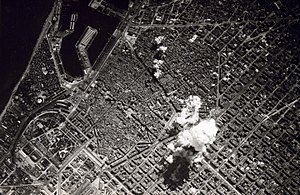
Back قصف بساطي Arabic Дывановыя бамбардзіроўкі Byelorussian Bombardeig en estora Catalan Kobercové bombardování Czech Tæppebombning Danish Flächenbombardement German Bombardeo en alfombra Spanish بمباران اشباع Persian Mattopommitus Finnish Tapis de bombes French



Carpet bombing, also known as saturation bombing, is a large area bombardment done in a progressive manner to inflict damage in every part of a selected area of land.[1][2][3][4] The phrase evokes the image of explosions completely covering an area, in the same way that a carpet covers a floor. Carpet bombing is usually achieved by dropping many unguided bombs.
Carpet bombing of cities, towns, villages, or other areas containing a concentration of protected civilians has been considered a war crime since 1977,[5] through Article 51 of Protocol I of the Geneva Conventions.[6][7][8]
The term obliteration bombing is sometimes used to describe especially intensified bombing with the intention of destroying a city or a large part of the city. The term area bombing refers to indiscriminate bombing of an area and also encompasses cases of carpet bombing, including obliteration bombing. It was used in that sense especially during World War II and the Korean War.[9]
- ^ Cite error: The named reference
WordNetwas invoked but never defined (see the help page). - ^ Cite error: The named reference
Keanewas invoked but never defined (see the help page). - ^ Cite error: The named reference
Dicksonwas invoked but never defined (see the help page). - ^ Gooderson, Ian (1997). Air power at the battlefront: Allied Close Air Support in Europe, 1943–45 (1st ed.). London: F. Cass. p. 129. ISBN 0-7146-4680-6.
- ^ "Crimes of War – Carpet or Area Bombing". Archived from the original on 2 December 2015. Retrieved 8 December 2015.
- ^ "Carpet bombing". Britannica.com. Retrieved 21 June 2019.
- ^ "Treaties, States parties, and Commentaries - Additional Protocol (I) to the Geneva Conventions, 1977 - 51 - Protection of the civilian population". International Committee of the Red Cross. 8 June 1977. Retrieved 21 June 2019.
- ^ "Treaties, States parties, and Commentaries - Additional Protocol (I) to the Geneva Conventions, 1977 - 51 - Protection of the civilian population - Commentary of 1987". Paragraph 5. International Committee of the Red Cross. Retrieved 21 June 2019.
- ^ Cite error: The named reference
pwas invoked but never defined (see the help page).
© MMXXIII Rich X Search. We shall prevail. All rights reserved. Rich X Search